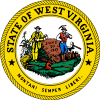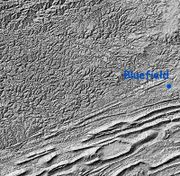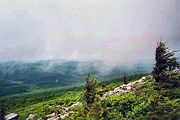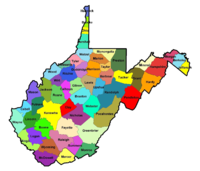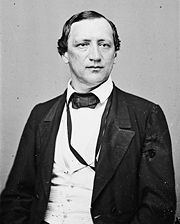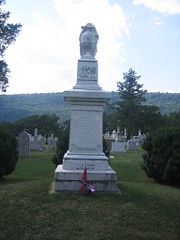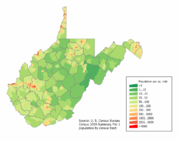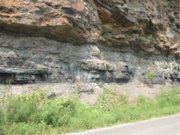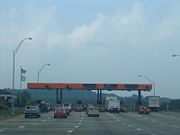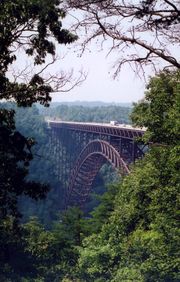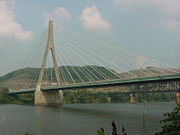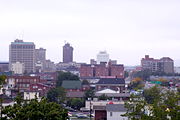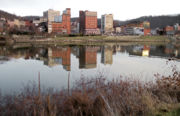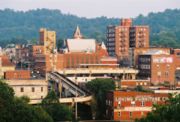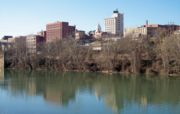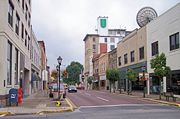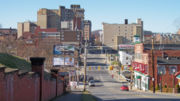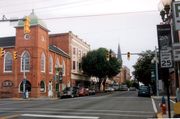West Virginia
2008/9 Schools Wikipedia Selection. Related subjects: North American Geography
| State of West Virginia | |||||||||||
|
|||||||||||
| Official language(s) | none (de facto English) | ||||||||||
| Demonym | West Virginian | ||||||||||
| Capital | Charleston | ||||||||||
| Largest city | Charleston | ||||||||||
| Largest metro area | Charleston metro area | ||||||||||
| Area | Ranked 41st in the US | ||||||||||
| - Total | 24,230 sq mi (62,755 km²) |
||||||||||
| - Width | 130 miles (210 km) | ||||||||||
| - Length | 240 miles (385 km) | ||||||||||
| - % water | 0.6 | ||||||||||
| - Latitude | 37° 12′ N to 40° 39′ N | ||||||||||
| - Longitude | 77° 43′ W to 82° 39′ W | ||||||||||
| Population | Ranked 37th in the US | ||||||||||
| - Total | 1,808,344 | ||||||||||
| - Density | 75.1/sq mi 29.0/km² (27th in the US) |
||||||||||
| - Median income | $38,029 (48th) | ||||||||||
| Elevation | |||||||||||
| - Highest point | Spruce Knob 4,863 ft (1,427 m) |
||||||||||
| - Mean | 1,500 ft (460 m) | ||||||||||
| - Lowest point | Harpers Ferry 240 ft (73 m) |
||||||||||
| Admission to Union | June 20, 1863 (35) | ||||||||||
| Governor | Joe Manchin (D) | ||||||||||
| Lieutenant Governor | Earl Ray Tomblin | ||||||||||
| U.S. Senators | Robert C. Byrd (D) Jay Rockefeller (D) |
||||||||||
| Congressional Delegation | List | ||||||||||
| Time zone | Eastern: UTC-5/ -4 | ||||||||||
| Abbreviations | WV US-WV | ||||||||||
| Website | www.wv.gov | ||||||||||
West Virginia (IPA: /ˌwɛstvɚˈdʒɪnjə/) is a state in the Appalachia / Upland South region of the United States. West Virginia broke away from Virginia during the American Civil War and was admitted to the Union as a separate state on June 20, 1863 (an anniversary now celebrated as West Virginia Day in the state). It is one of only two states formed during the American Civil War (along with Nevada) and is the only state to form by seceding from a Confederate state and one of two states to secede from another state ( Kentucky also seceded from Virginia but before the Civil War).
West Virginia is one of the Civil War " Border States". The Census Bureau considers West Virginia part of the South because most of the state is south of the Mason-Dixon Line, though its northern panhandle extends adjacent to Pennsylvania and Ohio with Weirton on a parallel with Pittsburgh, Pennsylvania. The unique position of West Virginia means that it is included in a wide variety of geographical regions (though often only marginally), such as the Upland South, the Southeastern United States, the Southern United States, the Mid-Atlantic, Appalachia and even the Midwestern United States and Northeastern United States. Notably, it is the only state which entirely lies within the area served by the Appalachian Regional Commission, which is a common definition of "Appalachia". While West Virginians recognize that their state is part of Appalachia, many do not welcome the term for purposes of self-identification. The state's Northern Panhandle, and North-Central region feel an affinity for Pittsburgh, Pennsylvania. Also, those in the Eastern Panhandle feel a connection with the Washington, D.C. suburbs in Maryland and Virginia, and southern West Virginians often consider themselves Southerners. Finally, the towns and farms along the mid- Ohio River have an appearance and culture somewhat resembling the Midwest. The capital and largest city is Charleston.
The state is noted for its great natural beauty, its historically significant logging and coal mining industries, and its labor history. It is also known as a tourist destination for those people interested in outdoor activities such as skiing, whitewater rafting, rock climbing, fishing, hiking, mountain biking and hunting.
Geography
West Virginia is bordered by Pennsylvania to the north; by Ohio to the north and west; by Kentucky to the west; by Maryland to the north and east; and by Virginia to the east and south. The Ohio and Potomac rivers form parts of the boundaries.
West Virginia is the only state in the nation located entirely within the Appalachian Mountain range, and in which all areas are mountainous; for this reason it is nicknamed The Mountain State. About 75% of the state is within the Cumberland Plateau and Allegheny Plateau regions. Though the relief is not high, the plateau region is extremely rugged in most areas.
On the eastern state line with Virginia, high peaks in the Monongahela National Forest region give rise to an island of colder climate and ecosystems similar to those of northern New England and eastern Canada. The highest point in the state is atop Spruce Knob, at 4,863 ft (1,482 m), is covered in a boreal forest of dense spruce trees at altitudes above 4,000 feet (1,220 m). Spruce Knob lies within the Monongahela National Forest and is a part of the Spruce Knob-Seneca Rocks National Recreation Area. A total of six wilderness areas can also be found within the forest. Outside the forest to the south, the New River Gorge is a 1,000-foot (304 m) deep canyon carved by the New River. The National Park Service manages a portion of the gorge and river that has been designated as the New River Gorge National River, one of only 15 rivers in the U.S. with this level of protection.
Other areas under protection and management include:
|
|
The native vegetation for most of the state was originally mixed hardwood forest of oak, chestnut, maple, beech, and white pine, with willow and American sycamore along the state's waterways. Many of the areas are rich in biodiversity and scenic beauty, a fact that is appreciated by native West Virginians, who refer to their home as Almost Heaven. Ecologically, most of West Virginia falls into the Appalachian mixed mesophytic forests ecoregion.
The underlying rock strata are sandstone, shale, bituminous coal beds, and limestone laid down in a near shore environment from sediments derived from mountains to the east, in a shallow inland sea on the west. Some beds illustrate a coastal swamp environment, some river delta, some shallow water. Sea level rose and fell many times during the Mississippian and Pennsylvanian eras, giving a variety of rock strata. The Appalachian Mountains are some of the oldest on earth, having formed over 300 million years ago.
Climate
The climate of West Virginia borders on a humid subtropical climate ( Koppen climate classification Cfa) in the lower elevations of the southwestern portion of the state (including Huntington and Charleston), along with parts of the Eastern Panhandle east of the Appalachians with hot, humid summers and milder winters. The rest of the state has a humid continental climate ( Koppen climate classification Dfa, except Dfb at the higher elevations) with warm to hot, humid summers and cold winters, increasing in severity with elevation. However, the weather is subject in all parts of the state to change. The hardiness zones range from zone 5b in the central Appalachian mountains to zone 7a in the warmest parts of the lowest elevations. In the Eastern Panhandle and the Ohio River Valley temperatures are warm enough to see and grow subtropical plants such as Southern magnolia ( Magnolia grandiflora), Crepe Myrtle, Albizia julibrissin, American Sweetgum and even the occasional needle palm and sabal minor. These plants don't thrive as well in other parts of the state.
Average January temperatures range from around 28°F (-2°C) near the Cheat River to 43°F (5°C) along sections of the border with Kentucky. July averages range from 67°F (19°C) along the North Branch Potomac River to 76°F (24°C) in the western part of the state. It is cooler in the mountains than in the lower sections of the state.
Annual precipitation ranges from less than 32 inches (810 mm) in the lower eastern section to more than 56 inches (1,400 mm) in higher parts of the Allegheny Front. Slightly more than half the rainfall occurs from April to September. Dense fogs are common in many valleys of the Kanawha section, especially the Tygart Valley. West Virginia is also one of the cloudiest states in the nation, with the cities of Elkins and Beckley ranking 9th. and 10th. in the U.S. respectively for the number of cloudy days per year (over 210). In addition to persistent cloudy skies caused by the damming of moisture by the Alleghenies, West Virginia also experiences some of the most frequent precipitation in the nation, with Snowshoe averaging nearly 200 days a year with either rain or snow. Snow usually lasts only a few days in the lower sections but may persist for weeks in the higher mountain areas. An average of 34 inches (86 cm) of snow falls annually in Charleston, although during the winter of 1995-1996 more than three times that amount fell as several cities in the state established new records for snowfall. Average snowfall in the Allegheny Highlands can range up to 180 inches per year.
| Monthly normal high and low temperatures for various West Virginia cities | ||||||||||||
| City | Jan | Feb | Mar | Apr | May | Jun | Jul | Aug | Sep | Oct | Nov | Dec |
|---|---|---|---|---|---|---|---|---|---|---|---|---|
| Beckley | 39/22 | 43/25 | 52/32 | 62/41 | 71/49 | 77/57 | 80/61 | 79/60 | 73/54 | 63/42 | 52/34 | 43/26 |
| Charleston | 43/24 | 47/27 | 57/34 | 67/42 | 75/50 | 82/58 | 85/63 | 84/62 | 77/55 | 67/43 | 56/35 | 47/28 |
| Elkins | 39/18 | 44/20 | 53/27 | 63/35 | 72/44 | 78/53 | 82/58 | 80/57 | 74/50 | 64/37 | 53/29 | 44/22 |
| Huntington | 41/24 | 46/28 | 56/36 | 67/44 | 75/53 | 82/61 | 85/65 | 84/64 | 77/57 | 66/45 | 55/37 | 45/29 |
History
West Virginia's unique geography allowed for exploration from two concurrent directions and a duality of a "Border State".
Prehistory
The area now known as West Virginia was a favorite hunting ground of numerous Native American peoples before the arrival of European settlers. Many ancient man-made earthen mounds from various mound builder cultures survive, especially in the areas of Moundsville, South Charleston, and Romney. Although little is known about these civilizations, the artifacts uncovered give evidence of a complex, stratified culture that practiced metallurgy.
European exploration and settlement
In 1671, General Abram Wood, at the direction of Royal Governor William Berkeley of the Virginia Colony, sent a party which discovered Kanawha Falls. In 1716, Governor Alexander Spotswood with about thirty horsemen made an excursion into what is now Pendleton County. John Van Metre, an Indian trader, penetrated into the northern portion in 1725. The same year, German settlers from Pennsylvania founded New Mecklenburg, the present Shepherdstown, on the Potomac River, and others followed.
King Charles II of England, in 1661, granted to a company of gentlemen the land between the Potomac and Rappahannock rivers, known as the Northern Neck. The grant finally came into the possession of Thomas Fairfax, 6th Lord Fairfax of Cameron, and in 1746, a stone was erected at the source of the North Branch Potomac River to mark the western limit of the grant. A considerable part of this land was surveyed by George Washington between 1748 and 1751. The diary kept by the surveyor indicates that there were already many squatters, largely of German origin, along the South Branch Potomac River. Christopher Gist, a surveyor in the employ of the first Ohio Company, which was composed chiefly of Virginians, explored the country along the Ohio River north of the mouth of the Kanawha River between 1751 and 1752. The company sought to have a fourteenth colony established with the name " Vandalia". Many settlers crossed the mountains after 1750, though they were hindered by Native American resistance. Few Native Americans lived permanently within the present limits of the state, but the region was a common hunting ground, crossed by many trails. During the French and Indian War the scattered British settlements were almost destroyed.
In 1774, the Crown Governor of Virginia John Murray, 4th Earl of Dunmore, led a force over the mountains, and a body of militia under then-Colonel Andrew Lewis dealt the Shawnee Indians, under Hokoleskwa (or "Cornstalk"), a crushing blow during the Battle of Point Pleasant at the junction of the Kanawha and the Ohio rivers. Native American attacks continued until after the American Revolutionary War. During the war, the settlers in western Virginia were generally active Whigs and many served in the Continental Army, however Claypool's Rebellion of 1780-1781 where a group of men refused to pay Colonial taxes showed war-weariness in West Virginia.
Trans-Allegheny Virginia, 1776-1861
Social conditions in western Virginia were entirely unlike those in the eastern portion of the state. The population was not homogeneous, as a considerable part of the immigration came by way of Pennsylvania and included Germans, Protestant Ulster-Scots, and settlers from the states farther north. During the American Revolution, the movement to create a state beyond the Alleghanies was revived and a petition for the establishment of "Westsylvania" was presented to Congress, on the grounds that the mountains made an almost impassable barrier on the east. The rugged nature of the country made slavery unprofitable, and time only increased the social, political, economic and cultural differences (see Tuckahoe-Cohee) between the two sections of Virginia.
The convention that met in 1829 to form a new constitution for Virginia, against the protest of the counties beyond the mountains, required a property qualification for suffrage and gave the slave-holding counties the benefit of three-fifths of their slave population in apportioning the state's representation in the U.S. House of Representatives. As a result, every county beyond the Alleghenies except one voted to reject the constitution, which nevertheless passed because of eastern support. Though the Virginia Constitution of 1850 provided for white male suffrage, the distribution of representation among the counties continued to give control to the section east of the Blue Ridge Mountains. Another grievance of the west was the large expenditure for internal improvements at state expense by the Virginia Board of Public Works in the East compared with the scanty proportion allotted to the West.
Separation from Virginia
West Virginia is the only state in the Union to secede from a confederate state, Virginia, during the American Civil War. On April 17, 1861 fifteen of the forty-six delegates from the area located in the present state of West Virginia voted to secede from the United States. Almost immediately after the vote to proceed with secession prevailed in the Virginia General Assembly, a mass meeting at Clarksburg recommended that each county in northwestern Virginia send delegates to a convention to meet in Wheeling on May 13, 1861. When this First Wheeling Convention met, 425 delegates from 25 counties were present, though more than one-third of the delegates were from the northern panhandle area, but soon there was a division of sentiment. Some delegates favored the immediate formation of a new state, while others argued that, as Virginia's secession had not yet been passed by the required referendum, such action would constitute revolution against the United States. It was decided that if the ordinance were adopted (of which there was little doubt), another convention including the members-elect of the legislature should meet at Wheeling in June. At the election on May 23, 1861, secession was ratified by a large majority in the state as a whole, but in the western counties approximately 34,677 voted against and 19,121 voted for the Ordinance.
The Second Wheeling Convention met as agreed on June 11 and declared that, since the Secession Convention had been called without the consent of the people, all its acts were void, and that all who adhered to it had vacated their offices. The Wheeling Conventions, and the delegates themselves, were never actually elected by public ballot to act on behalf of western Virginia. An act for the reorganization of the government was passed on June 19. The next day Francis H. Pierpont was chosen by other delegates at the convention to be governor of Virginia, other officers were elected and the convention adjourned. The legislature was composed of 103 members, 33 of whom had been elected to the Virginia General Assembly on May 23. This number included some hold-over Senators from 1859, and as such had vacated their offices to convene in Wheeling. The other members "were chosen even more irregularly-some in mass meetings, others by county committee, and still others were seemingly self-appointed" They met on June 20 and filled the remainder of the state offices, organized a state government and elected two United States senators who were recognized at Washington, D.C. At that point, therefore, there were two state governments in Virginia, one pledging allegiance to the United States and one to the Confederacy.
The Wheeling Convention, which had taken a recess until August 6, then reassembled on August 20, and called for a popular vote on the formation of a new state and for a convention to frame a constitution if the vote should be favorable. At the election on October 24, 1861, 18,489 votes were cast for the new state and only 781 against. Most of the affirmative votes came from ten counties in the Wheeling area. Over 50,000 votes had been cast on the Ordinance of Secession, yet the vote on statehood gathered only a little over 19,000. In Ohio County, home to Wheeling, a little over one-quarter of the voters cast a vote. At the Constitutional Convention in November 1861, Mr. Lamb of Ohio County and Mr. Carskadon said that in Hampshire County, out of 195 votes only 39 were cast by citizens of the state, the rest by Union soldiers. In most of what would become West Virginia, there was no vote at all as two-thirds of the territory of West Virginia had voted for secession and county officers were still loyal to Richmond. Votes recorded from Secession counties were mostly cast in the northwest by Unionist refugees from those counties. The convention began on November 26, 1861, and finished its work on February 18, 1862, and the instrument was ratified (18,162 for and 514 against) on April 11, 1862.
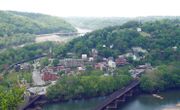
On May 13, the state legislature of the reorganized government approved the formation of the new state. An application for admission to the Union was made to Congress, and on December 31, 1862, an enabling act was approved by President Abraham Lincoln admitting West Virginia, on the condition that a provision for the gradual abolition of slavery be inserted in the Constitution. Many, including Lincoln, felt that West Virginia's admission as a state was unconstitutional, but wartime politics prevailed. The Convention was reconvened on February 12, 1863, and the demand was met. The revised constitution was adopted on March 26, 1863, and on April 20, 1863, President Lincoln issued a proclamation admitting the state at the end of sixty days ( June 20, 1863). Meanwhile officers for the new state were chosen and Governor Pierpont moved his capital to Alexandria where he asserted jurisdiction over the counties of Virginia within the Federal lines.
The question of the constitutionality of the formation of the new state was brought before the Supreme Court of the United States in the following manner: Berkeley and Jefferson counties lying on the Potomac east of the mountains, in 1863, with the consent of the reorganized government of Virginia voted in favour of annexation to West Virginia. Many voters absent in the Confederate Army when the vote was taken refused to acknowledge the transfer upon their return. The Virginia General Assembly repealed the act of secession and in 1866 brought suit against West Virginia asking the court to declare the counties a part of Virginia. Meanwhile, Congress, on March 10, 1866, passed a joint resolution recognizing the transfer. The Supreme Court, in 1870, decided in favour of West Virginia.
During the American Civil War, West Virginia suffered comparatively little. George B. McClellan's forces gained possession of the greater part of the territory in the summer of 1861, culminating at the Battle of Rich Mountain, and Union control was never seriously threatened, in spite of the attempt by Robert E. Lee in the same year. In 1863, General John D. Imboden, with 5,000 Confederates, overran a considerable portion of the state. Bands of guerrillas burned and plundered in some sections, and were not entirely suppressed until after the war ended.
The area which became West Virginia furnished about an equal number of soldiers to the Federal and Confederate governments , approximately 22,000-25,000 each. The Wheeling government found it necessary in 1865 to strip voting rights from returning Confederates. James Ferguson, who proposed the law, said that if it was not enacted he would lose election by 500 votes. The property of Confederates might be confiscated, and in 1866 a constitutional amendment disfranchising all who had given aid and comfort to the Confederacy was adopted. The addition of the Fourteenth and Fifteenth Amendments to the United States Constitution caused a reaction, the Democratic party secured control in 1870, and in 1871, the constitutional amendment of 1866 was abrogated. The first steps toward this change had been taken, however, by the Republicans in 1870. On August 22, 1872, an entirely new constitution was adopted.
Beginning in Reconstruction, and for several decades thereafter, the two states disputed the new state's share of the pre-war Virginia government's debt, which had mostly been incurred to finance public infrastructure improvements, such as canals, roads, and railroads under the Virginia Board of Public Works. Virginians, led by former Confederate General William Mahone, formed a political coalition which was based upon this theory, the Readjuster Party. Although West Virginia's first constitution provided for the assumption of a part of the Virginia debt, negotiations opened by Virginia in 1870 were fruitless, and in 1871, that state funded two-thirds of the debt and arbitrarily assigned the remainder to West Virginia. The issue was finally settled in 1915, when the Supreme Court of the United States ruled that West Virginia owed Virginia $12,393,929.50. The final installment of this sum was paid off in 1939.
Demographics
| Historical populations | |||
|---|---|---|---|
| Census | Pop. | %± | |
| 1790 | 55,873 |
|
|
| 1800 | 78,592 | 40.7% | |
| 1810 | 105,469 | 34.2% | |
| 1820 | 136,808 | 29.7% | |
| 1830 | 176,924 | 29.3% | |
| 1840 | 224,537 | 26.9% | |
| 1850 | 302,313 | 34.6% | |
| 1860 | 376,688 | 24.6% | |
| 1870 | 442,014 | 17.3% | |
| 1880 | 618,457 | 39.9% | |
| 1890 | 762,794 | 23.3% | |
| 1900 | 958,800 | 25.7% | |
| 1910 | 1,221,119 | 27.4% | |
| 1920 | 1,463,701 | 19.9% | |
| 1930 | 1,729,205 | 18.1% | |
| 1940 | 1,901,974 | 10% | |
| 1950 | 2,005,552 | 5.4% | |
| 1960 | 1,860,421 | −7.2% | |
| 1970 | 1,744,237 | −6.2% | |
| 1980 | 1,949,644 | 11.8% | |
| 1990 | 1,793,477 | −8% | |
| 2000 | 1,808,344 | 0.8% | |
The centre of population of West Virginia is located in Braxton County, in the town of Gassaway .
As of 2005, West Virginia has an estimated population of 1,816,856, which is an increase of 4,308, or 0.2%, from the prior year and an increase of 8,506, or 0.5%, since the year 2000. This includes a natural decrease since the last census of 3,296 people (that is 108,292 births minus 111,588 deaths) and an increase from net migration of 14,209 people into the state. Immigration from outside the United States resulted in a net increase of 3,691 people, and migration within the country produced a net increase of 10,518 people.
Only 1.1% of the state's residents were foreign-born, placing West Virginia last among the 50 states in that statistic. It has the lowest percentage of residents that speak a language other than English in the home (2.7%).
The five largest ancestry groups in West Virginia are: American (23.2%), German (17.2%), Irish (13.5%) (Many actually Scots-Irish), English (12%), Italian (4.8%).
Large numbers of people of German ancestry are present in the northeastern counties of the state.
5.6% of West Virginia's population were reported as under 5, 22.3% under 18, and 15.3% were 65 or older. Females made up approximately 51.4% of the population.
There were 20,928 births in 2006. Of these, 19,757 (94.40% of the births, 95.19% of the population) were to Non-Hispanic Whites. There were 22 births to American Indians (0.11% of the births and 0.54% of the population), 177 births to Asians (0.85% of the births and 0.68% of the population), 219 births to Hispanics (1.05% of the births and 0.88% of the population) and 753 births to Blacks and others (3.60% of the births and 3.56% of the population).
| Demographics of West Virginia (csv) | |||||
|---|---|---|---|---|---|
| By race | White | Black | AIAN* | Asian | NHPI* |
| 2000 (total population) | 96.01% | 3.49% | 0.59% | 0.66% | 0.05% |
| 2000 (Hispanic only) | 0.63% | 0.04% | 0.02% | 0.01% | 0.01% |
| 2005 (total population) | 95.99% | 3.56% | 0.56% | 0.69% | 0.05% |
| 2005 (Hispanic only) | 0.80% | 0.04% | 0.02% | 0.01% | 0.01% |
| Growth 2000–05 (total population) | 0.46% | 2.49% | -3.96% | 5.57% | -2.80% |
| Growth 2000–05 (non-Hispanic only) | 0.28% | 2.30% | -4.24% | 5.96% | -0.52% |
| Growth 2000–05 (Hispanic only) | 27.74% | 21.51% | 5.56% | -20.22% | -16.67% |
| * AIAN is American Indian or Alaskan Native; NHPI is Native Hawaiian or Pacific Islander | |||||
Economy
The economy of West Virginia is one of the most fragile of any U.S. state. According to U.S. Census Bureau data, West Virginia is the third lowest in per capita income, ahead of only Arkansas and Mississippi. It also ranks last in median household income. The proportion of West Virginia's adult population with a bachelor's degree is the lowest in the U.S. at 15.3%.
West Virginia's GDP was $55.6B in 2006, which was a 0.6% increase from 2005. This makes growth rate for the state the 2nd lowest in the nation, behind only Michigan.
One of the major resources in West Virginia's economy is coal. According to the Energy Information Administration, West Virginia is a top coal-producer in the United States, second only to Wyoming. West Virginia produces minimal oil and natural gas. Nearly all of the electricity generated in West Virginia is from coal-fired power plants. West Virginia produces a surplus of electricity and leads the Nation in net interstate electricity exports. Farming is also practiced in West Virginia, but on a limited basis because of the mountainous terrain over much of the state.
West Virginia personal income tax is based on federal adjusted gross income (not taxable income), as modified by specific items in West Virginia law. Citizens are taxed within 5 income brackets, which range from 3.0% to 6.5%. The state's consumer sales tax is levied at 6%. Effective January 1, 2004 calculation of WV consumer sales tax has been converted to a calculated figure from the bracket system, and remains at six percent for most goods (food goods are now taxable at four percent). The computation of tax is carried out to the third decimal place and rounded up when the third decimal place is five (.005) or higher; and similarly rounded down if the third place is four (.004) or lower. By virtue of this method, sales totaling $0.08 and below would not have a sales tax associated with them.
West Virginia counties administer and collect property taxes, although property tax rates reflect levies for state government, county governments, county boards of education, and municipalities. Counties may also impose a hotel occupancy tax on lodging places not located within the city limits of any municipality that levies such a tax. Municipalities may levy license and gross receipts taxes on businesses located within the city limits and a hotel occupancy tax on lodging places in the city. Although the Department of Tax and Revenue plays a major role in the administration of this tax, less than one-half of one percent of the property tax collected goes to state government. The primary beneficiaries of the property tax are county boards of education. Property taxes are paid to the sheriff of each of the state's 55 counties. Each county and municipality can impose its own rates of property taxation within the limits set by the West Virginia Constitution. The West Virginia legislature sets the rate of tax of county boards of education. This rate is used by all county boards of education statewide. However, the total tax rate for county boards of education may differ from county to county because of excess levies. The Department of Tax and Revenue supervises and otherwise assists counties and municipalities in their work of assessment and tax rate determination. The total tax rate is a combination of the tax levies from four state taxing authorities: state, county, schools, and municipal. This total tax rate varies for each of the four classes of property, which consists of personal, real, and intangible properties. Property is assessed according to its use, location, and value as of July 1. All property is reappraised every three years; annual adjustments are made to assessments for property with a change of value. West Virginia does not impose an inheritance tax. Because of the phase-out of the federal estate tax credit, West Virginia's estate tax is not imposed on estates of persons who died in 2005.
Transportation
Highways form the backbone of transportation systems in West Virginia, with over 37,300 miles of public roads in the state. Airports, railroads, and rivers complete the commercial transportation modes for West Virginia. Commercial air travel is facilitated by airports in Charleston, Huntington, Morgantown, Beckley, Bluefield, Lewisburg, Clarksburg, Martinsburg, Wheeling, and Parkersburg. Cities like Charleston, Huntington, Clarksburg, Fairmont, Bluefield, and Logan have bus-based public transit systems. Charleston also has a limited number of trolley cars that run primarily through the downtown area. West Virginia University in Morgantown boasts the PRT (personal rapid transit) system, the state's only single rail public transit system. Developed by Boeing, the WVU School of Engineering and the Department of Transportation, it was a model for low-capacity light transport designed for smaller cities. It was also the model for DisneyWorld's tram system. Recreational transportation opportunities abound in West Virginia, including hiking trails, rail trails, ATV off road trails, white water rafting rivers, and two tourist railroads ( Cass Scenic Railroad, and the Potomac Eagle Scenic Railroad.)
West Virginia is crossed by several interstate highways. I-64 enters the state near White Sulphur Springs in the mountainous east, and exits for Kentucky in the west, near Huntington. I-77 enters from Virginia in the south, near Bluefield. It runs north past Parkersburg before it crosses into Ohio. I-64 and I-77 are merged in a stretch of toll road known as the West Virginia Turnpike, on which construction began in 1952. It runs from just east of Charleston south to the exit for Princeton. I-68's western terminus is in Morgantown. From there it runs east into Maryland. At the I-68 terminus in Morgantown, it meets I-79, which enters from Pennsylvania and runs through the state to its southern terminus in Charleston. I-70 briefly runs through West Virginia, crossing the northern panhandle through Wheeling. I-81 also briefly runs in West Virginia through the Eastern Panhandle where it goes through Martinsburg.
Rail lines in the state used to be more prevalent, but many lines have been discontinued because of increased automobile traffic. Many old tracks have been converted to rail trails for recreational use, and the state is still served by a few commercial lines for hauling coal and by Amtrak. In 2006 Norfolk Southern along with the West Virginia and U.S. Government approved a plan to modify many of the rail tunnels in West Virginia, espeically in the southern half of the state, to allow for double stacked cars (see intermodal freight). This is expected to also help bring economic growth to the southern half of the state.
Because of the mountainous nature of the entire state, West Virginia has several notable tunnels and bridges. The most famous of these is the New River Gorge Bridge, which was at a time the longest steel single-arch bridge in the world with a 3,031-foot (924 m) span. The bridge is also pictured on the West Virginia state quarter. The Veterans Memorial Bridge (Weirton-Steubenville Bridge) was at its time of construction one of only three cable-stayed steel girder trusses in the United States. It connects Steubenville, Ohio with Weirton, West Virginia along US Route 22.
Law and government
West Virginia's capital and seat of government is the city of Charleston, located in the southwest area of the state.
Legislative branch
The West Virginia Legislature is bicameral, consisting of the House of Delegates and the Senate. It is a citizen's legislature, meaning that legislative office is not a full-time occupation, but rather a part-time position. Consequently, the legislators often hold a full-time job in their community of residence.
Typically, the legislature is in session for 60 days between January and early April. The final day of the regular session ends in a bewildering fury of last-minute legislation in order to meet a constitutionally imposed deadline of midnight. During the remainder of the year, monthly interim sessions are held in preparation for the regular session. Legislators also gather periodically for 'special' sessions when called by the governor.
Executive branch
The governor, elected every four years on the same day as the U.S. Presidential election, is sworn in during the following January.
Governors of West Virginia can serve two consecutive terms but must sit out a term before serving a third term in office.
Judicial branch
West Virginia is one of thirteen states that does not have a death penalty.
For the purpose of courts of general jurisdiction, the state is divided into 31 judicial circuits. Each circuit is made up of one or more counties. Circuit judges are elected in partisan elections to serve eight-year terms.
West Virginia’s highest court is the Supreme Court of Appeals. The Supreme Court of Appeals of West Virginia is the busiest appellate court of its type in the United States. West Virginia is one of 11 states with a single appellate court. The state constitution allows for the creation of an intermediate court of appeals, but the Legislature has never created one. The Supreme Court is made up of five justices, elected in partisan elections to 12-year terms.
West Virginia is an alcoholic beverage control state. However, unlike most such states, it does not operate retail outlets, having exited that business in 1990. It retains a monopoly on wholesaling of distilled spirits only.
Politics
At the state level, West Virginia's politics are largely dominated by the Democratic Party, with Democrats currently holding the governorship, both senate seats, two of three house seats and both houses of the state legislature. West Virginia also has a very strong tradition of union membership. In the Republican landslide of 1988, it was one of only ten states, and the only southern state (as defined by the US Census), to give its electoral votes to Michael Dukakis; it was one of only six states to support Jimmy Carter over Ronald Reagan in 1980; and it supported Bill Clinton by large margins in both 1992 and 1996. However, the West Virginia State Democratic Party, like many State Democratic Parties in the South, is on the whole more moderate than the national party. For example, Senator Robert Byrd was a member of the bipartisan Gang of 14, while Governor Joe Manchin and Congressmen Alan Mollohan and Nick Rahall are pro-life on the issue of abortion. Furthermore, the state has trended increasingly Republican in Presidential elections; despite the earlier Democratic wins in Presidential matchups mentioned, it narrowly elected George W. Bush over Al Gore in 2000, then re-elected Bush by a much larger margin in 2004, and John McCain has usually polled well ahead of Barack Obama for the 2008 matchup.
The most consistent support for Democrats is found in the coal fields of southern West Virginia (especially McDowell, Mingo, Logan, Wyoming, and Boone Counties), while Republicans are most numerous to the east of the Allegheny Mountains, especially in the state's Eastern Panhandle and Potomac Highlands. The Northern Panhandle and North-Central West Virginia regions usually split right down the middle in terms of being Republican or Democrat.
Important cities and towns
Large cities (> 10,000 population)
|
|
Towns and small cities
|
|
|
|
|
|
Metropolitan Statistical Areas
|
|
Micropolitan Statistical Areas
|
|
Education
West Virginia has received low marks for reading and math skills at the eighth-grade level and ranked 51st in college education rates.
Colleges and universities
|
|
Sports
| Club | Sport | League |
|---|---|---|
| West Virginia Mountaineers | Football | College Football |
| Marshall Thundering Herd | Football | College Football |
| Bluefield Orioles | Baseball | Appalachian League |
| Princeton Devil Rays | Baseball | Appalachian League |
| West Virginia Power | Baseball | South Atlantic League |
| Wheeling Nailers | Ice hockey | ECHL |
| West Virginia Wild | Basketball | International Basketball League |
| Huntington Heroes | Indoor football | American Indoor Football Association |
| West Virginia Crash | Football | United States Football Alliance |
| Ohio Valley Greyhounds | Indoor football | United Indoor Football |
| West Virginia Chaos | Soccer | USL Premier Development League |

